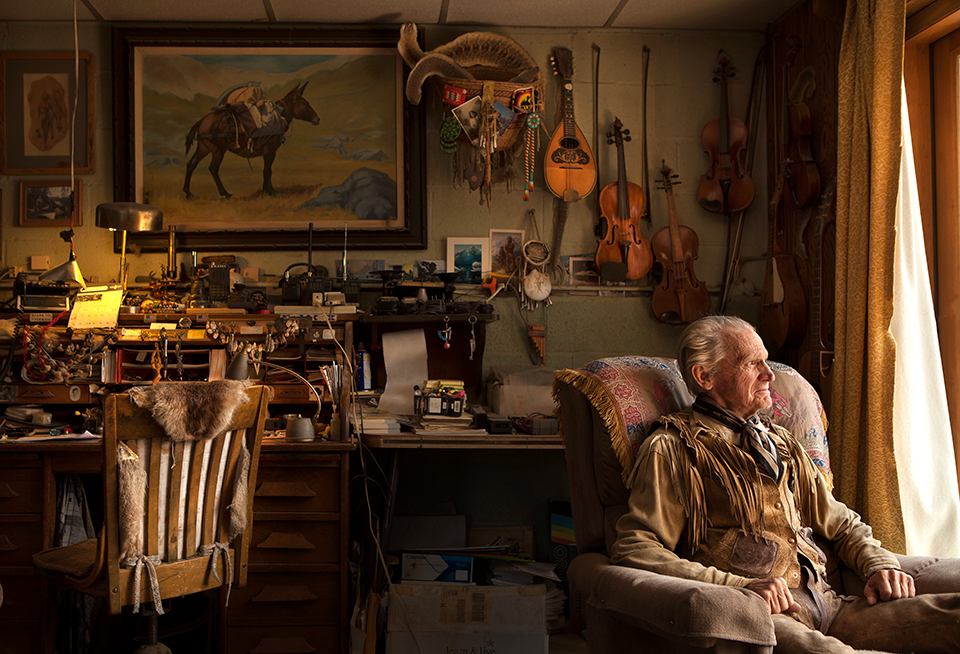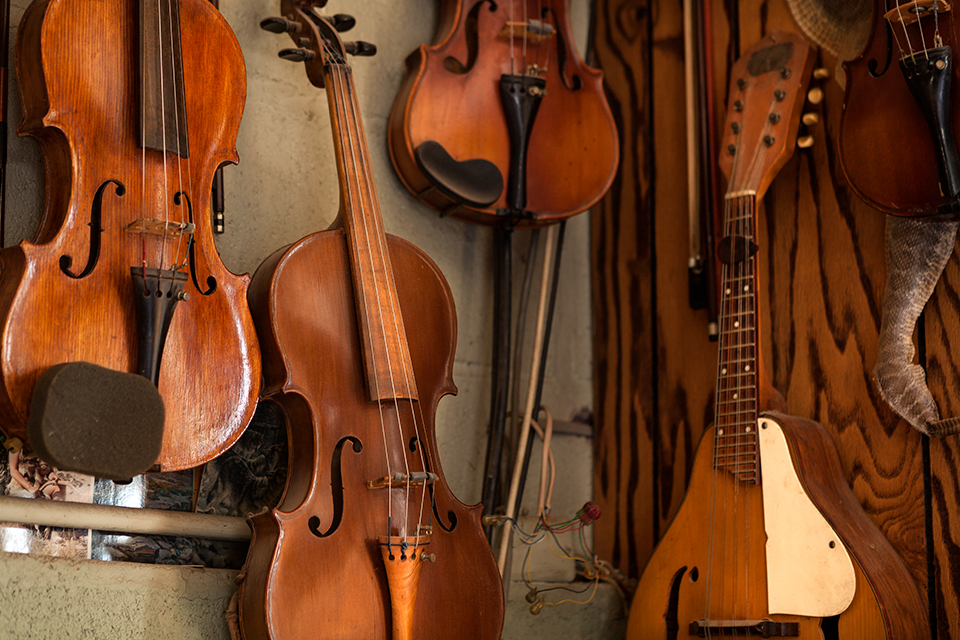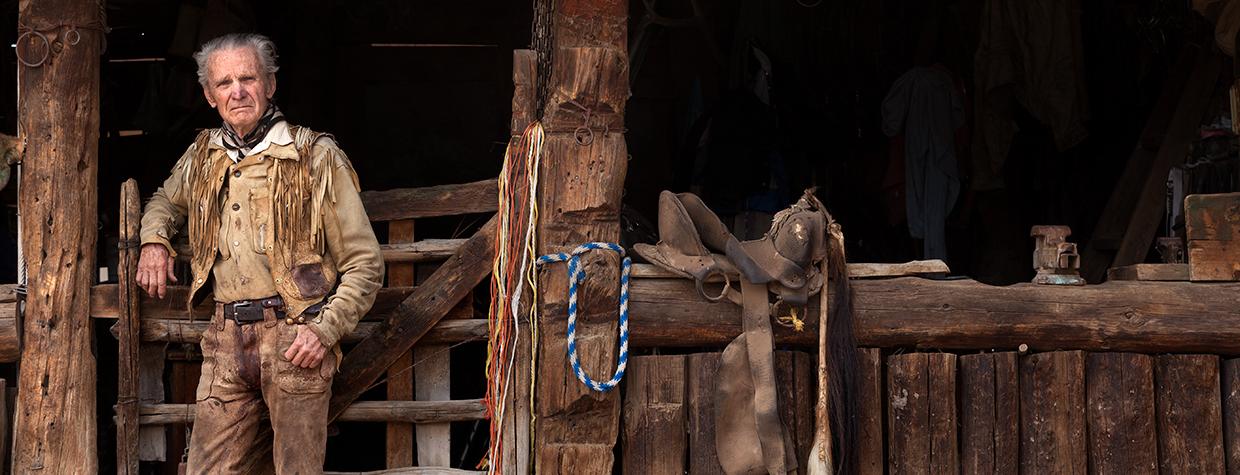We’d have met Sam Luce much sooner had it not been for the dogs. Two of them — part German shepherd, part redtick coonhound — began barking as soon as we pulled through the gate at the end of Luce Ranch Road.
They didn’t stop.
Not when we parked the cars. Not when photographer Scott Baxter called out for Luce. Not when we wandered into the shade to let the dogs settle, then attempted again our slow approach to the front door.
We would be patient, though, because we’d heard about these dogs, Oso and Judy. Luce has them to keep wolves off his property. The dogs are beautiful and big. And loud.
Besides, it was the kind of day you lock away in your memory for when the weather turns viciously hot or bitterly cold — the kind where the breeze stirs apple blossoms and the smell of earth mixes with the warmth of sun and you feel spring somewhere in your bones.
We nuzzled a pony that grazed in a small patch of grass and made small talk as the minutes passed. And then Sam Luce appeared in his sunroom like a spirit. He called out to go ahead and make our way to the door. He would meet us there, and the dogs would be “just fine.”
Down along Campbell Blue Creek, Luce is a legend. “Doc.” “Doc Luce.” “The Maverick Doctor.” These are just some of the names you hear in nearby Alpine when you mention you’ve been down to visit him. Then the people there will spin their own story or two about the time Doc Luce …
… roped a maverick bull.
… tended to a patient who’d shattered his kneecap — with his own .38.
… was slammed into a corral post by an angry mule, and how he lay in the mud with a broken back for hours until his wife, Julie, found him.
But when Luce answers the door in bare feet and handmade cowhide pants, running his fingers through his fine gray hair, there’s a glimmer in his eyes that says his own stories will be the best.

At 85 years old and 5 feet, 5 inches, Luce moves in the manner of someone a half-century younger. He is neither slowed by age nor feebled by a life lived the way he wanted it. He is, if a person had to describe him, spry. Bright. Brave.
“My wife and I had medical practices in Estes Park, Colorado,” Luce says as he curls into a beige recliner that matches his shirt and pants. “But Julie was a pediatrician who decided to be a psychiatrist, and her practice just got busier and busier.” He, too, was in demand, as an emergency-room doctor.
They’d been in Estes Park because it afforded them a chance to ride their horses — she was a champion equestrian and horse jumper, he a former jockey — and explore the outdoors during their time off.
“It started off being fairly nice — it was a small town,” Luce says. “But as time went on, the business got busier and busier, and we weren’t able to use our horses and go riding. We ended up having three kids, and we liked to take them on trips, and we wanted more time. So, after the summer rush in Estes Park one fall, we decided to take a look and see if we could find a small area that wouldn’t be very busy.”
They found Blue.
And when they did, one of the residents said the tiny community needed a schoolteacher.
“I understand the two of you are doctors, so you went to school, didn’t you?” Luce remembers the man saying. He laughs, and his blue eyes flash. “Julie said, ‘Well, I’d like to teach at a school like this.’ So, we decided there were possibilities.”
The one-room school came with a house, and they imagined that life on the Blue could be a retirement of sorts. So the Luces gathered their children and went west.
After a while, people discovered that the Luces were doctors and would stop by with minor ailments, but, for the most part, the family had settled quietly into its new routine. And there were, of course, a few major traumas over the years.
As it turns out, the story about the man shooting himself in the kneecap is true. As is one about a man who battered his skull in a terrible accident. Running out of time, Doc Luce operated on him — up on the mountain. He saved the man’s life.
Life on the Blue is simple. And it isn’t. There is peace. The silence of space, the running of water. The colors of dirt and sky and field. There is a dull and lovely sense of isolation.
But then, one January, the unthinkable happened when the family drove into a canyon. Deer cut across the road and up a hill, kicking off a cascade of rocks.
“One came bouncing through the passenger-side window, and it hit our daughter, Stormy, in the head, causing a very serious brain injury,” Luce says. “We went down to Barrow Neurological Institute, and she had surgery.”
It wasn’t expected that Stormy would regain consciousness, and doctors warned that if she did, she wouldn’t much resemble the way she was before the accident.
So the family returned to Estes Park, and Stormy woke up. Slowly, she walked again. She regained sight and hearing. And over the years, she developed enough ability to live independently. Then, the Luces bought the Jack Brooks Ranch, including its 250 head of cattle, and returned to the Blue.
That was 46 years ago. Today, Stormy lives in Springerville.
Life on the Blue is simple. And it isn’t.
There is peace. The silence of space, the running of water. The colors of dirt and sky and field. There is a dull and lovely sense of isolation.
There is time to pack deep into the Blue Range Primitive Area in search of hot springs, as the Luces have done countless times. Time to doctor on San Carlos Apache Tribe land, as Luce did 15 years ago. Time to build things and work on trucks and play fiddles — several of which hang on the wall behind Luce as he tells the story of how he met Julie, how he put himself through medical school by shoeing horses and playing in a dance band.
There is work. The moving of cattle, the tending to horses and dogs and barn cats. Fence-mending, always. The near-constant opening and closing of gates. There is a dark and piercing sense of isolation.
Over time, the Luces reduced their herd, first to 25 cows, then to 10. Now, they have one. In an interview for the Arizona Memory Project, Luce recounts his reasons for culling the cattle:
“This was more work than we wanted to do, so we reduced down, you might say, to 10 percent. We went down to 25 head. We found that 25 head, when we were out there branding and getting kicked in the face by a yearling steer, was still plenty of work. We raised a pretty good field of corn. We fed our cattle from the pasture, and then raised corn that we added to their feed. Gradually, we have moderated. We find it more fun to go camping than we do to brand calves.”
The interview, which presents a sort of oral history of ranching on the Blue, took place February 4, 2011 — just months before the Wallow Fire burned 538,049 acres in Arizona and New Mexico, and threatened the Luce Ranch.

As he settles into his retelling of this particular story, the flash in his eyes fades. Because his beloved ranch nearly burned.
The fire, driven by wind, approached early on in its march through the White Mountains. The U.S. Forest Service dispatched two tankers down Luce Ranch Road, and firefighters unloaded pumps, hoses, sprinklers and more.
“The fire was burning 4 or 5 miles up the canyon,” Luce says. “You could see the smoke and fire going 500 feet in the air, so they started putting their pumps in my irrigation ditch and laying out fire hoses so they could squirt water on the buildings to keep them from burning — and it was very good, because that was going to save this place. So many other places burned.”
Of course, Luce worked with the fire crew.
“I heard a walkie-talkie start squawking, ‘You guys have to evacuate immediately,’ ” he says. “ ‘There are embers blowing a half-mile in your direction. You can’t stop them. Get out immediately.’ ”
The firefighters left. They abandoned their equipment. So, over the next several days, Luce defended the ranch alone, using the Forest Service’s high-pressure pumps to douse outbuildings.
On the second day, he evacuated Julie — she was having trouble breathing — then returned to keep fighting the fire.
“About 4 o’clock in the morning, I was over working on the log house where K.T. lives now,” Luce says — referring to his ranch hand, K.T. Thompson, who lives and works on the ranch with his two daughters. “It was so hot, the water I’d squirt on the house would turn to steam. It melted a black plastic pipe that was a vent pipe. Here came a man walking in here on foot. Guy by the name of Vicente Ramirez.“
The cowboy had been down the canyon to visit friends. He heard Luce needed help. He went.
The isolation was, briefly, overcome.
“Of all the people in this canyon — and I know them all — he was the only one who came in,” Luce says. And Ramirez stayed. Eventually, Luce’s youngest son, Matt, a heavy-equipment operator, joined them. The three men fought the fire for 10 days.
Today, the sides of some of the buildings are singed, but the smell of smoke is long gone. As we walk around his property — Luce has put on a jacket, a bandanna and boots — the doc shows us his tack room, his beautiful saddles, the craftsmanship of fences and log cabins and corrals. There’s an understated pride in his words, a knowledge that he is part of the long ranching tradition on the Blue — a heritage he hopes he can cling to.
“What we have on the canyon here is the remnants of a community,” Luce says. “We don’t have as large a cattle industry as once held us together.”
The light is golden as Luce stands in the doorway of one of the log cabins. Thompson’s daughters return from school and begin their chores — after they stop to hug the doc. He smiles and cracks a joke and kicks at the ground with a boot. Oso lingers at his side.
Together, they walk through the gate. They don’t stop.

